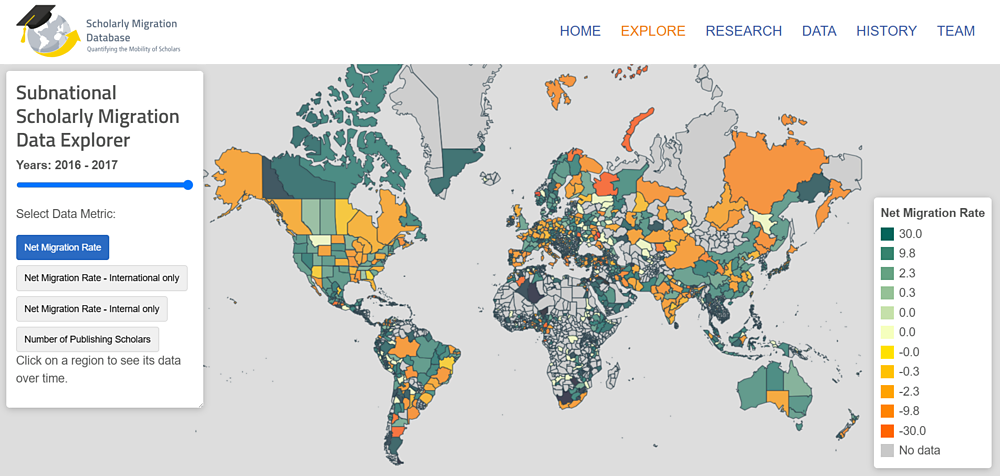May 14, 2025 | Press Release
Where the Brightest Minds in Science Moved
Study reveals global patterns of the migration of scientists shedding light on how researchers move both within and between countries
A team of researchers at the Max Planck Institute for Demographic Research (MPIDR) expanded the regional data included in the Scholarly Migration Database to examine how scientists move internationally across countries and internally within countries. The team found large disparities in the appeal of various countries and regions to scientists. When a region within a country is a popular destination for scientists, they come from both within the country and from abroad. Less attractive destinations see more complex patterns.

For their study, MPIDR researcher analyzed more than 33 million publications by more than 19 million authors and measured migrations based on changes in institutional affiliations between 1996 to 2020. © istockphoto.com/Ziga Plahutar
- Expanded Database: The Scholarly Migration Database (SMD) now includes a comprehensive global dataset detailing the migration patterns of scientists at both internal and international levels
- Interactive Visualization: The SMD website now includes an interactive visualization that allows users to explore internal and international migration trends worldwide
- Rising Inequality: Over the past two decades inequality in international migration of scientists has intensified, with certain subnational regions, such as California, benefiting from larger inflows of academic talent
- Consistent Patterns: Some regions, such as Beijing, have been consistently sending scientists abroad while others, such as Trentino-Alto Adige in Italy, have become popular destinations for scientists
Today, we aspire for innovation across many areas of society, with scientific research laying the foundation for these innovations. This competition drives countries worldwide to attract the brightest scientific minds. Highly qualified researchers also boost the inventive spirit of the local population. Understanding which countries succeed in attracting scientific talent, and identifying the most popular regions within these countries are useful in planning policies and incentives.
In their latest study, researchers from the Max Planck Institute for Demographic Research (MPIDR) examined differences in the migration of scientific talent for 211 countries and territories worldwide. Published in the scientific journal PNAS, the study examines both internal migration within countries and international movement between them. The MPIDR team looked at how many scientists relocate domestically compared to how many go abroad, and they analyzed which regions within a country are particularly attractive to move to from abroad and which regions are popular to move away from. “We aimed to understand, for the first time, how scientists move within a country, as well as how migration of scientists within and across countries are interrelated,” explains Aliakbar Akbaritabar, lead author of the study and researcher at MPIDR.

Global subnational estimates of migration of scholars reveal novel patterns of spatial heterogeneity. The net migration rates shown in the map include both internal and international moves. The map shows that even in the same country, the subnational regions are not all attractive (green colors) or sending (red colors) to the same level, and there are large disparities between regions. © MPIDR
Download Figure (PNG File, 879 kB)
For their study, Akbaritabar and his colleagues analyzed more than 33 million publications by more than 19 million authors and measured migrations based on changes in institutional affiliations between 1996 to 2020. “Our research provides the first detailed and comprehensive examination of mobility of scientists at the subnational level over the past two decades. It shows that specific subnational regions benefit from a significant inflow of internal and international academic talent. For instance, regions in the western United States have until recently consistently attracted scholars from around the world” says Akbaritabar. However, other US regions that have positive inflows from abroad also lose a large proportion of their researchers to other regions within the US, reflecting broader general demographic trends in the US where academics tend to migrate east to west.
This suggests that while mobility facilitates interregional and international collaboration, benefiting the entire scientific community, the concentration of scientific talent in selected subnational regions could foster the emergence of innovation hubs. These regions may gain a cumulative advantage as a critical mass of scientists attracts even more talent, funding, and collaborators.
The MPIDR team found a distinct pattern in the case of some subnational regions. “Some regions across all continents have consistently sent scientists abroad for over ten years in a row, such as Beijing, China. In contrast, other regions, such as Trentino-Alto Adige in Italy, have been consistently receiving scientists from abroad over the same time span. Further research using our publicly accessible data in the Scholarly Migration Database can uncover reasons behind these trends, and address the regional implications in the future,” says Akbaritabar.
Mecklenburg-Vorpommern: an interesting case in Germany
The state of Mecklenburg-Vorpommern in Germany is an intriguing case. “Over the past decade this northern state has lost more scientists to other regions in Germany than it gained. Following German unification, it initially became an attractive destination for scientists in Germany. “I noted, however, a rapid increase in scientists relocating to Berlin (within Germany) as well as to Asia (internationally),” says Thiago Zordan Malaguth, a PhD Student at the MPIDR who has previously used these data to look into trends of academic migration in Germany.

On average, subnational inequalities in attracting and sending scholars have increased for international migration but decreased for internal migration. Year-specific, region-based weighted Gini coefficients across continents and six types of migration. For subnational regions in Asia and South America, and, to a lesser extent, in Europe, we see a pattern of increasing inequality in international migration and decreasing inequality in internal migration. © MPIDR
Download Figure (PNG File, 340 kB)
The differences in attractiveness among subnational regions presented in this study carry significant implications for science policy and practice. In some continents, inequality in international migration of scientists has been increasing, with fewer and fewer countries in these continents attracting academic talent. However, within individual countries the differences in attractiveness to move between regions are narrowing. This internal movement between these subnational regions contributes to the vibrancy of knowledge production and diffusion and has been vastly understudied in previous research due to a lack of data on subnational mobility. “Our study examined the underlying interrelation between the two systems of migration and found that certain subnational regions are attractive for both internal and international scientists,” says Maciej J. Dańko, co-author of the study. Conversely, some regions are at risk of experiencing major losses of their research workforce as they act as net senders of scholars to both internal and international destinations. Beijing, for example, is one such region at risk.
“Current government hostility towards science in the US points to the possibility that more scientists will relocate from the US to Europe. However, it is still too early to say whether that will happen” explains Emilio Zagheni, Director of the MPIDR and co-author of the study. “Based on our previous research, I suspect that Europeans based in the US will be more likely to want to return to Europe.”
Original Publication
Akbaritabar, A., Dańko, M.J., Zhao, X., Zagheni, E.: Global subnational estimates of migration of scientists reveal large disparities in internal and international flows. PNAS (2025). DOI: 10.1073/pnas.2424521122
Keywords
Subnational Scientific Mobility, Internal Migration, International Migration, Bibliometric Data
Scholarly Migration Database offers a new feature

The new visualization tool allows data to be explored at the subnational level. © MPIDR
The Scholarly Migration Database provides detailed data on the mobility of scholars. Researchers, journalists, and policy analysts interested in the mobility of scientists can access high quality data sets and estimates through this website. https://www.scholarlymigration.org/
Together with this publication, a new interactive visualization of the subnational migration data was added to the website. The new feature allows users to dive deep into the dataset and have a look at the scholarly migration history of any region in this dataset.
The Scholarly Migration Database is compiled and hosted by the Max Planck Institute for Demographic Research in Rostock, Germany.